Top>Research>Magnetism And Superconductivity - Seeking Unknown Order
 Index
Index
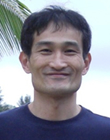
Hirohiko Sato [Profile]
Education Cource
Magnetism And Superconductivity
- Seeking Unknown Order
Hirohiko Sato
Professor of Condensed Matter Physics and Solid-State Chemistry, Faculty of Science and Engineering, Chuo University
Introduction
I conduct research regarding the artificial construction of crystallizations of new matter. I truly believe that searching for unknown matter is just as exciting as traveling through an unexplored universe. I have discovered about 10 new substances by using a hydrothermal synthesizer, a device which resembles an exaggerated pressure cooker. (Figure 1) Atoms and molecules are orderly aligned within the crystallizations. If it were possible to enter inside of the crystals, one would witness an overwhelmingly simple view. Imagine that you wandered into a condominium which has 100 million east-west rooms and 100 million north-south rooms sprawled over 100 million floors. Furthermore, imagine that residents of the condominium consisted of identical family structures living in identical room layouts. Why are physicists drawn to such simple objects?
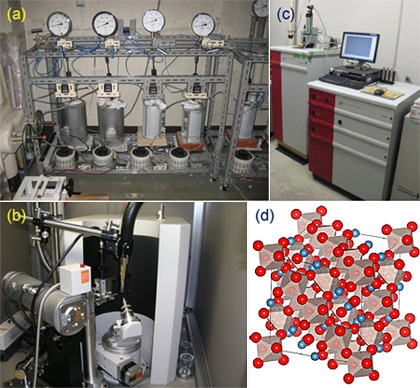
Figure 1: (a) Hydrothermal synthesizer. (b) X-ray diffractometer analyzing a crystalline structure. (c) SQUID magnetometer examining magnetic properties. (d) Example structure of matter discovered by Professor Sato.
Order within a magnet
Physicists are drawn to such objects because crystals are a stage on which the beautiful natural form of ツ“orderツ” appears. Letツ’s consider the familiar example of a magnet. Magnets possess a variety of properties. On relatively unknown property is that magnets will suddenly turn into an ordinary stone when heated to above a certain temperature. (Figure 2) Actually, when pursuing the cause of this phenomenon, one will arrive at the keyword of ツ“orderツ”. The atoms which make up a magnet each contain small magnets which are known as electron spins. If the direction of each spin becomes unsynchronized, the spins cancel each other out and the entire body will not function as a magnet. (Figure 3) In order for magnetic properties to be realized, it is necessary for all spins to orderly face in the same direction. (Figure 4) In other words, an object with magnetic properties can also be described as an object with orderly spins.
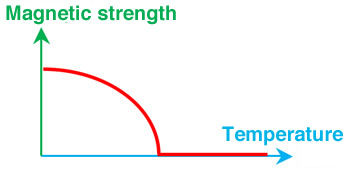
Figure 2: Relationship between strength and heat in magnets. Magnetic properties will suddenly disappear once a certain temperature is reached.
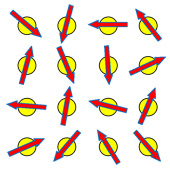
Figure 3: Disorganized electron spins. The body will not function as a magnet.
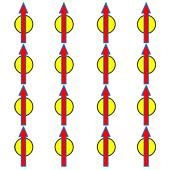
Figure 4: Orderly spins within a magnet.
Phase transition
When looking at Figure 2, it seems strange that an order which did not exist at high temperatures will suddenly occur when a lower temperature is reached. All of the spins suddenly face the same direction at once, making it seem as if the spins possess a collective consciousness. However, this is not the case. Actually, this phenomenon can be completely explained through an extremely simple principle. This principle states that spins want to face the same direction as the adjacent spins. Temperature can be thought of as something like the capriciousness of spins. When the temperature is high, spins frequently wobble about and change their direction. In such a situation, a spin doesnツ’t know which direction it should face because all of the surrounding spins are facing in haphazard directions. As a result, an overall condition is maintained in which the direction of spins is unsynchronized. When the temperature is gradually decreased, there is an appearance of groups of spins which seem to be facing in the same direction. Then, once the temperature has fallen to a certain point, it is extremely difficult for an individual spin to defy the direction of its surrounding companions, and all spins face in the same direction. This kind of rapid change in order is known as phase transition. Another example of phase transition is how water suddenly turns into ice once its temperature is lowered to 0 degrees Celsius.
Order created by the power of groups
In the case of most phenomena, a small change in conditions will only bring about a small result. However, in the case of phase transition, a very small difference in temperature leads to the existence or non-existence of order, which is a dramatic difference. The power of groups is involved with this phenomenon. On a slightly different note, human beings that have formed a group will sometimes suddenly embark on an unbelievable course of action. In a ツ“high-temperatureツ” society, each individual possesses diversity and is allowed to behave flexibly based on individual judgments. The loss of such diversity and flexibility is equivalent to the act of cooling. Furthermore, what happens when we add the psychology of having to possess the same opinion of surround individuals? Once a certain ツ“temperatureツ” has been reached, human beings suddenly become unable to act in defiance of surrounding constraints and all of society becomes the same. Japanese people possess a national trait of trying to read the atmosphere and adjust their behavior to the surrounding situation. However, magnets show us how this trait contains the danger of changing into sudden rush due to a slight change in passions.
Antiferromagnets
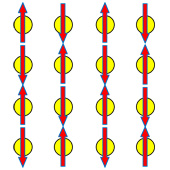
Figure 5: Orderly condition of an antiferromagnet
Letツ’s return to the subject of magnets. Generators, motors and hard disks are all obvious examples of how dependent our lifestyle is on magnets. In the future, it will be necessary to develop magnets which possess even more outstanding properties. However, the perfect order which appears in ordinary magnets is of no further interest as the subject of physics research. Rather, physics is interested in the kind of order that results when the occurrence of such simple order is suppressed as much as possible. In this respect, there is more appeal to be found in antiferromagnets which, unlike ordinary magnets (ferromagnets), contain spins which want the opposite direction of adjacent spins. In the case of antiferromagnets, spins are disorderly and unsynchronized at high temperatures (Figure 3). However, once the temperature has fallen below a certain point, the spins suddenly align in alternating directions. (Figure 5) Although antiferromagnets possess outstanding order, they do no function as magnets and therefore receive almost no attention from the perspective of application.
Frustration
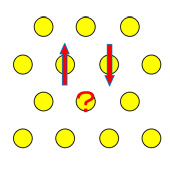
Figure 6: An antiferromagnet that contains frustration. It is impossible to align the spins so that all adjacent spins face the opposite direction. For example, when positioning 2 spins as shown by the arrows in the figure, it is difficult to decide the direction of the spin to be placed in the location indicated by the question mark (?).
Now, letツ’s be a little mischievous and construct an antiferromagnet that possesses a crystalline structure which is formed by triangles (Figure 6). In this case, it is impossible to realize an alignment in which all adjacent spins face in the completely opposite direction. Spins are unable to create the simple order which they desire. This condition is described as containing frustration. Conversely, the laws of thermodynamics predict that some kind of order must appear in all objects once the temperature has been sufficiently decreased. When actually performing experiments, a variety of order appears in conditions with frustration. There is a variety of known orders which can be introduced. For example, there is a spin array in which adjacent spins face a direction which is 120 degrees opposite of each other and a spin array with a stripe-like pattern in which the triangular relationship has been dissolved by warping of the crystal. There is a spin glass state of spins in which their direction is unsynchronized and the spins have become unable to move. There is even a spin liquid state in which 2 spins form a pair and cancel each other out, only to have the partner in the pair change constantly. I believe that unknown orders will be discovered in the future. What will be the form of these new orders? I suppose it is too bold to think that value exists in my research because of the inability to predict such orders?
Superfluids
Moving to a topic different from magnetic bodies, I would like to introduce a case in which research into unpredictable fields resulted in the discovery of astounding order. When matter is cooled, it changes from gas to liquid and from liquid to solid. Atoms are aligned with regularity in solids, and solids can therefore be described as the most orderly state. However, helium is a unique substance which tends to remain as a liquid and resist freezing. There was a group of researchers who continued to cool helium without any idea of what would occur. The researchers discovered that when the temperature fell below -271 degrees Celsius, the helium remains in a liquid state but substance now as a superfluid suddenly appears. The properties of liquid when in a superfluid condition are totally in contrast with what we consider to be common sense. For example, assume that a cup filled with water is covered with plastic wrap, the cup is turned upside down, and a needle is used to poke holes in the wrap. If the holes are small, water does not spill. Furthermore, water does not spill if the cup is covered with gauze and turned upside down. This phenomenon can be explained by the viscosity (stickiness) of water, a property which prevents water from passing through small holes. Conversely, superfluid liquid possesses absolutely no viscosity and will spill easily if the same experiment is repeated. But that is not all. If superfluid liquid is poured into a cup and the glass is left alone, the liquid will crawl up the sides of the cup and all of the liquid will leak outside of the cup. When conducting a detailed examination of this strange superfluid liquid, it can be seen that has a more highly ordered state than regular liquids. In other words, instead of changing into a solid state with regularly ordered atoms, helium has for some reason decided to change into a completely different order known as a superfluid. The order of superfluids may be slightly difficult to understand. This difficultly is related to quantum nature, a profound natural form that exists within superfluids.
Quantum nature
The field of classical mechanics, created by Newton, is in accordance with our common sense and can almost entirely explain the familiar phenomenon of the parabola drawn when matter is thrown. However, the field of classical mechanics is not entirely correct. Speaking precisely, matter follows the laws of quantum mechanics. However, the matter of quantum mechanics (quantum nature) only appears noticeably in the micro-world, such as the size of atoms. Therefore, we normally donツ’t have a chance to experience such laws. Quantum mechanics is governed by the rule of known as the ツ“vagueness of natureツ”. Strange things occur when this rule is applied to our world. For example, assume that you are involved in an accident and must substantiate your alibi. In order to satisfy the suspicions of the investigator, it is necessary to provide eyewitness information from a third party regarding the time and location that you were sighted. However, regardless of whether or not such a witness exists, you constantly exist in some location. Surely, there is no investigator who would doubt such an obvious fact. However, according to quantum mechanics, the certainty of your existence at some location cannot be guaranteed unless you are actually observed (seen). This strange phenomenon is commonplace among micro-matter such as atoms and electrons.
Particles or waves?
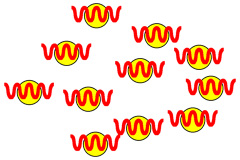
Figure 7: The duality of waves and particles. Atoms are fundamentally considered as particles, but they also possess the properties of waves. The yellow balls are atoms shown as particles, while the red lines are atoms shown as waves.
The duality of waves and particles exists within a single specific appearance of quantum nature. Until graduating from high school, you probably learned that light is a wave and that electrons are particles. However, upon in-depth examination of this subject, there were successive discoveries of the strange fact that light behaves like a particle and the electrons exhibit the properties of waves. Although it is correct to fundamentally consider electrons as particles, they also take on properties similar to waves. (Figure 7) To use a somewhat forced example, please imagine that electrons are stretching from your hand and that the electrons move as you wave your hand up and down. When focusing on the movement of your hand, it appears almost like a wave. The concept of phases is an important aspect of expressing a wave-like state. Phases are a method of expressing the momentary state of a wave through angles. For example, a phase of 0 degrees exists at the moment when your hand is at exactly the middle height of the movement and you are preparing to wave your hand upwards. A phase of 90 degrees exists at the moment when your hand has reached the highest point. A phase of 180 degrees exists at the moment when your hand has once again lowered to the middle height. Finally a phase of 270 degrees exists when your hand is at the lowest point. In this way, the movement of your hand is mapped using angles. Using this method, it is possible to understand the up and down movement of your hand as a state in which the phase angle moves in a circle.
Coherent state
Letツ’s consider an object in which a large number of these atoms have gathered. If each atom waves its hand at a varied timing, then the overall wave properties will be canceled out. This can also be described as a condition in which phases are disordered. A diagram like Figure 3 results when the phase angle is expressed as the direction of an arrow. The objects which surround us are similar to this state and lose their overall wave properties. Therefore, the properties of quantum mechanics are not readily apparent. Now, as in Figure 4, letツ’s consider a case in which the phase angles of a wave are in a uniform state. The movement of each atomツ’s hand is completely synchronized, and it would undoubtedly appear to be a single giant wave. This phenomenon can be understood by imagine the wave created by fans at a soccer stadium when cheering on their team. Even if the position of atoms is not methodically aligned, the state of uniform wave phases is beautiful and orderly. The term ツ“coherent stateツ” is used to refer to a state with this kind of quantum mechanical order. Actually, superfluids are a state in which groups of helium atoms have formed a coherent state. Superfluids express the strange properties of quantum mechanics in a size that is large enough for use to experience. As an aside, laser beams are also light particles which have formed a coherent state, while normal light is in a condition where each light phase is unsynchronized.
Superconductivity
Superconductivity is a phenomenon that is similar to superfluidity. Superconductivity can be considered as when the electrons which move around inside of a crystallization are in a coherent state. Just as there is no viscosity in superfluid liquids, there is absolutely zero electrical resistance in superconductive matter. For example, if an electric current is passed through a donut-shaped ring which is made of superconductive material, the electric current will flow forever. If this property is used in transmission lines, it is possible to carry electricity for long distances with absolutely no loss of energy. Other uses of superconductivity include the generation of a strong magnetic field, or use as the fundamental technological of a computer which performs ultra-rapid calculations based on completely new principles. In this way, the practical application of superconductive technology would certain effect great changes in our common sense. However, superconductivity is also a state in which a quantum mechanical order has occurred, and that order is destroyed when temperatures increase. For this reason, superconductivity currently occurs only at low temperatures. However, in contrast to superfluidity, which occurs only in the matter helium, superconductivity occurs in a variety of matter. Furthermore, although superconductivity was initially thought to occur only at temperatures of -270 degrees Celsius or lower, subsequent research artificially synthesized matter in which the phenomenon occurs at -140 degrees Celsius. We researchers are pursuing the dream of a material which is superconductive even at room temperature. The frustration antiferromagnet which was previously described in this article was originally thought to be of absolutely no relation to superconductivity. However, a theory has surfaced which calculates that a deep relationship actually exists.
In closing
Applied research performs a series of successive experiments based on a variety of principles. This process is similar to agriculture which creates crops through repeated breeding to improve species. In comparison, the fundamental research which I conduct may be inefficient, similar to diving into an unexplored jungle to search for a new variety of fruit. However, it cannot be forgotten that all agriculture originally began by picking wild species born by nature. Truly, as I walk through a world of unexplored materials for which results cannot be predicted, I am now only capable of searching for new order shown through the vagaries of nature. There is an increasingly strong trend of denying value in anything that is not immediately useful. Considering such trends, I am truly thankful to the university which allows me to conduct my enjoyable searches for new materials. All this aside, why are people drawn to order? While riding the train to work, I pondered this matter while staring blanking at the electric sign which announces the station names. Perhaps order is the essence of almost all objects that we believe exist in this world, including my own body. I became enveloped in such thoughts while running my eyes along the sign characters which are nothing more than an order created by groups of illuminated lamps.
- Hirohiko Sato
Professor of Condensed Matter Physics and Solid-State Chemistry Faculty of Science and Engineering, Chuo University - Born in Miyazaki Prefecture in 1965. Graduated from Kyoto University School of Science in 1988. Completed the Doctoral Program in chemistry at Kyoto University Graduate School of Science in 1993. Before assuming his current position in 2008, served as an IMS Fellow in the Institute of Molecular Science at the Okazaki National Research Institutes, as a Research Associate in the Faculty of Science at Tokyo Institute of Technology, and as an Assistant Professor in the Faculty of Science and Engineering, Chuo University.
- Research Activities as a Member of Research Fellowship for Young Scientists (DC1), Japan Society for the Promotion of Science (JSPS) Shuma Tsurumi
- Important Factors for Innovation in Payment Services Nobuhiko Sugiura
- Beyond the Concepts of Fellow Citizens and Foreigners— To Achieve SDGs Goal 10 “Reduce Inequality Within and Among Countries” Rika Lee
- Diary of Struggles in Cambodia Fumie Fukuoka
- How Can We Measure Learning Ability?
—Analysis of a Competency Self-Assessment Questionnaire— Yu Saito / Yoko Neha - The Making of the Movie Kirakira Megane








